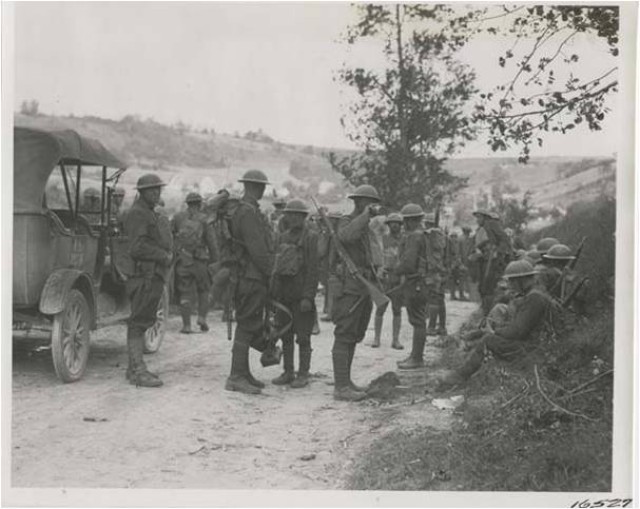In the early morning hours of August 27, 1918, 230 Pennsylvanians of the 28th Division trudged across the Vesle River into their defensive positions in the rubble- strewn village of Fismette, France. Less than an hour after taking up their fighting positions, these men would encounter the terror, confusion and savagery of the German principle of "Schwerpunkt," or focus of energy.
By August 1918, a series of Allied offensives sent the Imperial German Army reeling increasingly closer to its homeland. Although, the Allied attacks continually thinned its weary ranks, they did not lessen the ferocity of the veteran troops. Three years earlier, during the battle of Verdun, the German Army had implemented squads of heavily armed and fast moving assault troops. These storm troops would attack a specific objective on the Allied trench line. Under the cover of indirect fire, the troops would move into position near the objective. Once the artillery "softened up" the objective, the storm troops would swarm and clear out the remaining defenders, using hand grenades, flame throwers and submachine guns. They defended the gap until follow-on infantry arrived to exploit the opening. Fismette proved to be the perfect place to apply these tactics yet again.
In late August 1918, the Germans were pushed north of the Vesle River, which became the front line for that sector. On August 26, after some ferocious fighting, the Doughboys of Pennsylvania's 28th Division, captured Fismette. This created a bulge in the German line. Across the Vesle was the larger town of Fismes headquarters of the 112th Infantry Regiment, 28th Division. To the left of Fismes was the American 77th Division, and the right was secured by the 110th Infantry Regiment. On August 26, the American III Corps Commander, Major-General Robert Bullard, inspected the defenses at Fismes. He conferred with the Commander of the 112th, Colonel George C. Rickards, who requested permission to withdraw his advanced post out of Fismette. General Bullard denied the request, stated he would look at other options, and departed.
The Doughboys from G and H Companies, 112th Infantry took up their posts in the pre-dawn hours of August 27. Approximately 30 minutes later, German artillery shells began to impact all around the defenders. The troops took cover anywhere they could find. Before the artillery fire shifted, storm troops attacked positions on the left and right flanks, driving the Americans in toward the center of the village. Special flamethrower troops assaulted through the center of the town, flushing any remaining defenders out of the basements, while aircraft overhead were using the light from the flames to drop bombs on the U.S. garrison. Some of the Doughboys attempted to flee on the one bridge that led across to Fismes until German machine gunners turned it into a kill zone. By the time the fighting ceased, 200 men out of the force of 230 were killed, wounded or captured.
Following Fismette, G and H Companies were never reconstituted, and surviving members were assigned to other Companies within the 112th. The village itself was never recaptured. The 112th was pulled from Fismes in early September and trucked southward to new positions in support of the Oise-Aisne Offensive. The Germans later abandoned Fismette as the war pressed them closer to their own border. Fismette provided the world with a terrifying glimpse into the Schwerpunkt principle that the Wehrmacht would use 21 years later to take over nearly all of Western Europe and large swaths of the Soviet Union. In that Second World War, however, the storm troops would be replaced by large armored formations with mechanized panzer grenadiers and ground attack aircraft operating in close support. In both World Wars, the 28th Division would continue to fight with great bravery on the Western Front.
Related Links:
A Working Bibliography of MHI Sources: 28th Infantry Division
A Working Bibliography of MHI Sources: World War I- AEF Overview






Social Sharing